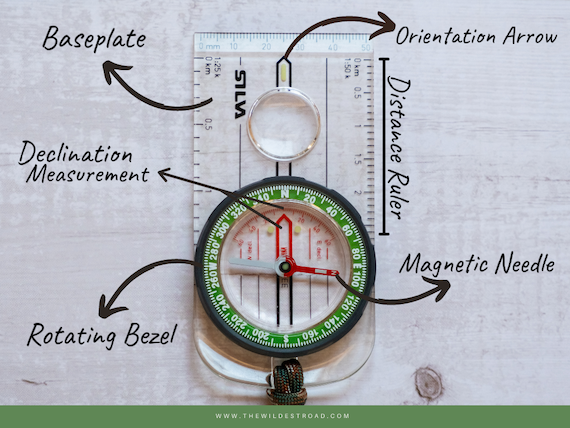A Hiker’s Guide On How to Use a Compass
When visiting the Great Outdoors, it’s often tempting to leave the trail and venture into the unknown.
However, once you’ve stepped off the road, the scenery can quickly start looking the same everywhere, and before you know it you’re lost with no idea of which way you came from and which way you’re heading.
It is important at that point to have the skills to find the way back home.
I imagine some of you might be familiar with the movie “The Blair Witch Project”. To avoid the same unfortunate fate met by the characters, any aspiring adventurer needs to be familiar with one of the main tools of navigation, the compass.
Let’s look at the basics of reading a compass!
First things first, you need to have a constant and unchanging reference. Your compass indicates four directions, represented by the four Cardinal Signs.
The four cardinal signs are: North, East, West and South
Now that we have established directions, let’s see how to read them on a compass.
To do that we first need to understand how a compass is made.
Keep in mind that this guide refers to a baseplate compass, which has a few extra features to aid in navigation. If you don’t have one, the best one I would recommend, and that I use personally, is the Silva Explorer 2.0. It’s cheap, reliable, and offers all the basic features you need to learn basic navigation skills.
A baseplate compass has 3 main parts:
Baseplate:
The base of the compass, it has a ruler to measure distances on a map and an orientation arrow to indicate which direction to point the compass in when using it.
Rotating bezel:
A rotating rubber circle located around the housing of the needle. It indicates the Cardinal Signs and has markings that go from 0° to 360°. These markings are used to indicate by how many degrees you are deviating from one of the cardinal signs.
Inside the rotating bezel you will see another set of indications in red, along with a large red arrow. Those are used for measuring the declination. More on that later.
Magnetic needle:
This rotating needle has a red coloured part that always faces towards magnetic north.
True North, Magnetic North and Hemispheres
Contrary to popular belief, there is not just one north.
There is of course only one geographically, but from a navigational point of view there are two norths, true and magnetic:
True north is a direct line towards the North Pole, and is what we need to find and use when orienting with a compass.
Magnetic north is instead what the needle will be pointing to, because it is being pulled by the Earth’s magnetic field.
It is important to always remember the distinction between the two, as following magnetic instead of true can send you several kilometres off course.
Where you are in the World not only affects the declination, it affects how your entire compass is built. Because a compass is affected by the magnetic field, that pull is different depending on whether you are in the northern or southern hemisphere.
Always make sure you have a compass made for the hemisphere you’re visiting.
Correcting for declination
If you have a compass laying around, I would suggest you go get it because it will make the next part much easier to follow. If not, remember that you can always pin this article and read it later.
We mentioned declination, so what is it?
Because the Earth’s magnetic field is constantly shifting, the distance between true and magnetic north varies based on location and time of the year.
The degree of distance between these two points is called the declination. To find true north, you must first know the value of the declination for your location.
This info is normally available online or on up to-date maps of the area in question.
The best way to get accurate info on declination is the interactive declination map of the National Oceanic and Atmospheric Administration (NOAA).
Remember that the declination is always shifting, so make sure the data you find is not obsolete!
After finding the value of the declination, first set the compass with north facing the orientation arrow. Hold the compass and rotate yourself until the red needle points to the declination value, let’s say for example 10° east. When the needle points in that direction, rotate the bezel until the large red arrow sits exactly under the needle.
The north on your bezel is now pointing towards true north and the compass is adjusted for declination. Whenever you need to find north, just rotate again until the red needle sits inside the red arrow.
When you need to head in any direction other than north, remember to always adjust for declination. To do that, simply start by lining the direction you want to follow with the orientation arrow. Adjust for declination, then rotate yourself until the north arrow sits inside the big red arrow.
You’re now facing the direction you want while accounting for declination.
And there you go, you’re now reading a compass like a pro!
𝘿𝙞𝙙 𝙮𝙤𝙪 𝙚𝙣𝙟𝙤𝙮 𝙩𝙝𝙞𝙨 𝙖𝙧𝙩𝙞𝙘𝙡𝙚 ?
𝘠𝘰𝘶 𝘤𝘢𝘯 𝘴𝘢𝘷𝘦 𝘰𝘳 𝘱𝘪𝘯 𝘵𝘩𝘪𝘴 𝘪𝘮𝘢𝘨𝘦 𝘴𝘰 𝘵𝘩𝘢𝘵 𝘺𝘰𝘶 𝘤𝘢𝘯 𝘢𝘭𝘸𝘢𝘺𝘴 𝘭𝘰𝘰𝘬 𝘣𝘢𝘤𝘬 𝘰𝘯 𝘵𝘩𝘦𝘴𝘦 𝘵𝘪𝘱𝘴 !











Not sure how to go about sharpening your favorite knife? In this essential beginner’s guide we go over the best ways to keep your knife sharp, the main tools you’ll need to sharpen your knife and the step by step on how to use sharpening tools to maintain your knife in top condition.